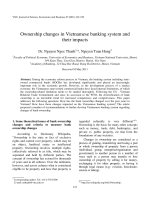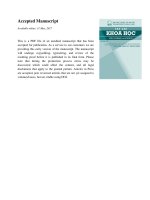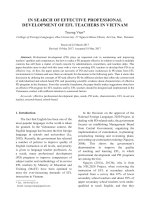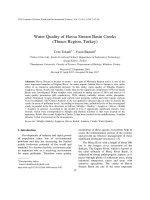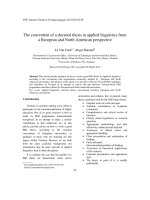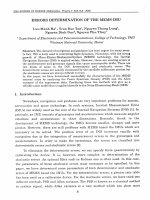DSpace at VNU: Author Profiling of Vietnamese Forum Posts - An Investigation on Content-based Features
Bạn đang xem bản rút gọn của tài liệu. Xem và tải ngay bản đầy đủ của tài liệu tại đây (217.99 KB, 11 trang )
Accepted Manuscript
Available online: 31 May, 2017
This is a PDF file of an unedited manuscript that has been
accepted for publication. As a service to our customers we are
providing this early version of the manuscript. The manuscript
will undergo copyediting, typesetting, and review of the
resulting proof before it is published in its final form. Please
note that during the production process errors may be
discovered which could affect the content, and all legal
disclaimers that apply to the journal pertain. Articles in Press
are accepted, peer reviewed articles that are not yet assigned to
volumes/issues, but are citable using DOI.
VNU Journal of Science: Comp. Science & Com. Eng., Vol. 33, No. 1 (2017) 1-10
Author Profiling of Vietnamese Forum Posts - An
Investigation on Content-based Features
Duong Tran Duc1,*, Pham Bao Son2, Tan Hanh1
1
Posts and Telecommunications Institute of Technology, Hanoi, Vietnam
2
VNU University of Engineering and Technology
Abstract
In this paper, we investigate the author profiling task for Vietnamese forum posts to predict demographic
attributes, such as gender, age, occupation, and location of the author. Although we conducted the experiments
on different types of features, including style-based and content-based features, we focused more on analyzing
the effects of content-based features. We used machine learning approaches to perform classification tasks on
datasets we collected from popular forums in Vietnamese. The results show that these kinds of features work
well on such a kind of short and free style messages as forum posts, in which, content-based features achieved
much better results than style-based features.
Received 16 February 2017, Revised 16 February 2017, Accepted 16 February 2017
Keywords: Author profiling, machine learning, content-based features.
1. Introduction*
people do not provide their personal
information or input the incorrect/unclear data.
As a result, the task of automatically
classifying the author’s properties such as
gender, age, location, occupation, etc. becomes
important and essential. Applications of this
task can be in commercial field, in which
providers can know which types of users like or
do not like their products/services (for target
marketing and product development). For the
social research domain, researchers also want to
know the profile of people who have a specific
opinion about some social issues (when doing a
social survey). It can also be used to support the
court, in term of identifying if a text was
created by a criminal or not [1].
Profiling the author of forum posts is also a
challenging task in comparison to doing this on
other formal types of text such as article, novel,
or even the other types of online texts such as
blog posts or emails. Forum posts are often
The rapid growth of World Wide Web has
created a lot of online channels for people to
communicate, such as email, blogs, social
networks, etc. However, online forum is still
one of the most popular channels for people to
share the opinions and discuss about the topics
which are interested in common. Forum posts
created by users can be considered as informal
and personal writings. Authors of these posts
can indicate their profiles for other people to
view as a function of forum. But not many
users reveal their personal information, because
of information privacy issues on the online
systems. Moreover, personal information of
users is not mandatory to input when they
register as a user of forums. Therefore, most of
_______
*
Corresponding author. E-mail.:
/>
1
2
D.T. Duc et al. / VNU Journal of Science: Comp. Science & Com. Eng., Vol. 33, No. 1 (2017) 1-10
short and written in free style, which may
contain grammar errors or informal sentence
structures.
Although most of previous works in author
profiling were conducted on online texts (blog
posts, emails), there are a litter works on more
informal style of texts such as forum posts.
These works also focused on the popular
languages such as English, Dutch, Chinese,
Greek, etc. [1, 4, 16, 23, 26]. As far as we have
known, there is only one work on author
profiling conducted in Vietnamese, but on blogs
and used style-based features only [6]. In this
work, we investigate the use of both style-based
and content-based features for author profiling
of Vietnamese forum posts, in which we report
a deeper analysis on content-based features.
This work is also an extension version of our
paper on author profiling which presented at
ACIIDS’16 [8]. In this paper, we investigated
further about the content-based features, such as
the best number of content-based features for
each trait (which yields the highest result), the
list of the most important features for each trait
with their weights and provide some analysis
about them. In addition, we also improve the
prediction results on some traits by applying the
Grid Search algorithm to select the best
parameters for SVM algorithm.
The organization of the paper is as follows.
In section 2, we present the related work on the
author analysis problem. Section 3 describes the
methods and the system. Section 4 presents the
result and discussion. In section 5, we draw a
conclusion and future work.
2. Related work
The problem of authorship analysis has
been studied for decades, mostly on English
and some other languages (Dutch, French,
Greek, Arabia etc.). In the early stage, it was
often conducted on the long and formal
documents such as article or novel. However,
since 1990s, when the WWW grew and created
a large amount of online text, the task of author
analysis has moved the focus to this type of
text, such as email, blog posts, forum posts [1,
7, 24].
According to Zheng et al. [26], the
authorship analysis studies can be classified
into three major fields, including authorship
attribution, authorship profiling, and similarity
detection.
Authorship attribution is the task of
determining if a text is likely written by a
particular author or not. It also is the technique
to identify which one from a set of infinite
authors is the real author of a disputed
document. Therefore, it is also called authorship
identification. The first study in this field dates
back to 19th century when Mendenhall (1887)
[14] investigated the Shakespeare’s plays. But
the work which was considered the most
thorough study in this field was conducted by
Mosteller and Wallace (1964) [15] when they
analyzed the authorship of FederalList Papers.
From that point, a number of works have been
conducted by various researchers, including [2,
5, 7, 11, 21, 23, 26].
Authorship profiling, also known as
authorship characterization, detects the
characteristics of an author (e.g. gender, age,
educational background, etc.) by analyzing the
texts created by him/her. This technique is
different from the former in that it is often used
to examine the anonymous text, which is
created by an unknown author, and generates
the profile of the author of that text. For this
reason, the author profiling task is often
conducted on the online documents rather than
literary texts. Therefore, this field is only more
concerned by researchers from the late of
1990s, when more and more online documents
are created by Internet’s users. The most typical
studies in this fields are from [2, 3, 4, 6, 9, 10,
11, 12, 16, 17, 18, 20, 22, 24].
Similarity detection, on the other hand,
doesn’t focus on determining the author or
his/her characteristics, but analyzes two or more
documents to find out if they are all created by
the same author or not. This technique is also
used to verify if a piece of text is written by the
D.T. Duc et al. / VNU Journal of Science: Comp. Science & Com. Eng., Vol. 33, No. 1 (2017) 1-10
author himself/herself or copied from the
product of other authors. This task is mostly
used for plagiarism detection. Some of the most
convincing studies in this field were conducted
by [2, 5, 7] and [11].
Regarding the process of authorship
analysis, there are two main issues that may
significantly affect the performance, namely
features set and analytical techniques [26].
Features set can be considered as a way to
represent a document in term of writing style.
With a chosen features set, a document can be
represented as a features vector in which entries
represent the frequency of each feature in the
text [12]. Although various types of features
have been examined, there is no features set
that is the best to all the cases. According to
Argamon et al. [4], there are two types of
features that often can be used for authorship
profiling: Style-based features and contentbased features.
Style-based features can be grouped into
three types, including lexical, syntactic, and
structural features. Lexical features are used to
measure the habit of using characters and words
in the text. The commonly used features in this
kind consist of the number of characters, word,
frequency of each kind of characters, frequency
of each kind of words, word length, sentence
length [7], and also the frequency of individual
alphabets, special characters, and vocabulary
richness [11]. Syntactic features include the use
of punctuations, part-of-speeches, and function
words. Function words feature is the interesting
kind of features, which is examined in a number
of studies and yielded very good results ([11,
22, 26]). The set of function words used is also
varying, from 122 to 650 words. Structural
features show how the author organizes his/her
documents (sentences, paragraphs, etc.) or other
special structures such as greetings or
signatures ([5, 11]).
Content-based features are often specific
words or special content which are used more
frequent in that domain than in other domains
[25. These words can be chosen by correlating
the meaning of words with the domain ([2],
3
[11]) or selecting from corpus by frequency or
by other feature selection methods [4].
Also the investigation of Zheng et al. [25]
showed that, in early studies most authorship
analytical techniques were statistical methods,
in which the probability distribution of word
usage in the texts of each author was examined.
Although these methods achieved good results
in authorship analysis, there are still some
limitations, such as the ability to deal with
multiple features or the stability over multiple
domains.
To overcome those limitations, the
extensive use of machine learning techniques
has been investigated. Fortunately, the advent
of powerful computers allows researchers to
conduct the experiments on complicated
machine learning algorithms, in which Support
Vector Machine (SVM) shows the better results
in many cases ([1, 2, 5, 6, 7, 11, 12, 18, 20, 22,
26]). Some other machine learning algorithms
also have been examined and achieved good
results, including Bayesian Network, Neural
Networks, Decision Tree ([4, 11, 22, 25]). In
general, machine learning methods have
advantages over statistical methods because
they can handle the large features sets and the
experiments also shown that they achieved the
better results.
This paper addresses the problem of author
profiling for forum posts, which are in type of
online text and written in free-style with short
length. For this kind texts, it may be difficult to
capture the pure style of authors and using
content words as discriminating features could
improve the author profiling results.
3. System description
3.1. System overview
In this work, we built a system which can
take sample texts from web crawlers, then used
text and linguistic processing components to
extract features to create the data sets for the
purpose of training the classifier. The classifier
4
D.T. Duc et al. / VNU Journal of Science: Comp. Science & Com. Eng., Vol. 33, No. 1 (2017) 1-10
then can be used to predict the profile of the
author of an anonymous forum post. Fig.1.
shows the overall structure of the system.
In the data processing step, data is selected,
cleaned and grouped by author profiles. Only
posts with length from 50 to 300 words (250 to
1500 characters) were used. We also applied
both automatic and manual text processing
activities such as eliminating the spam texts,
abnormalities, updating training labels, etc.
Un��������������������������������������������������������������������������������������������������������������������������������������������������������������������������������������������������������������������������������������������������������������������������������������������������������������������������������������������������������������������������������������������������������������������������������������������������������������������������������������������������������������������������������������������������������������������������������������������������������������������������������������������������������������������������������������������������������������������������������������������������������������������������������������������������������������������������������������������������������������������������������������������������������������������������������������������������������������������������������������������������������������������������������������������������������������������������������������������������������������������������������������������������������������������������������������������������������������������������������������������������������������������������������������������������������������������������������������������������������������������������������������������������������������������������������������������������������������������������������������������������������������������������������������������������������������������������������������������������������������������������������������������������������������������������������������������������������������������������������������������������������������������������������������������������������������������������������������������������������������������������������������������������������������������������������������������������������������������������������������������������������������������������������������������������������������������������������������������������������������������������������������������������������������������������������������������������������������������������������������������������������������������������������������������������������������������������������������������������������������������������������������������������������������������������������������������������������������������������������������������������������������������������������������������������������������������������������������������������������������������������������������������������������������������������������������������������������������������������������������������������������������������������������������������������������������������������������������������������������������������������������������������������������������������������������������������������������������������������������������������������������������������������������������������������������������������������������������������������������������������������������������������������������������������������������������������������������������������������������������������������������������������������������������������������������������������������������������������������������������������������������������������������������������������������������������������������������������������������������������������������������������������������������������������������������������������������������������������������������������������������������������������������������������������������������������������������������������������������������������������������������������������������������������������������������������������������������������������������������������������������������������������������������������������������������������������������������������������������������������������������������������������������������������������������������������������������������������������������������������������������������������������������������������������������������������������������������������������������������������������������������������������������������������������������������������������������������������������������������������������������������������������������������������������������������������������������������������������������������������������������������������������������������������������������������������������������������������������������������������������������������������������������������������������������������������������������������������������������������������������������������������������������������������������������������������������������������������������������������������������������������������������������������������������������������������������������������������������������������������������������������������������������������������������������������������������������������������������������������������������������������������������������������������������������������������������������������������������������������������������������������������������������������������������������������������������������������������������������������������������������������������������������������������������������������������������������������������������������������������������������������������������������������������������������������������������������������������������������������������������������������������������������������������������������������������������������������������������������������������������������������������������������������������������������������������������������������������������������������������������������������������������������������������������������������������������������������������������������������������������������������������������������������������������������������������������������������������������������������������������������������������������������������������������������������������������������������������������������������������������������������������������������������������������������������������������������������������������������������������������������������������������������������������������������������������������������������������������������������������������������������������������������������������������������������������������������������������������������������������������������������������������������������������������������������������������������������������������������������������������������������������������������������������������������������������������������������������������������������������������������������������������������������������������������������������������������������������������������������������������������������������������������������������������������������������������������������������������������������������������������������������������������������������������������������������������������������������������������������������������������������������������������������������������������������������������������������������������������������������������������������������������������������������������������������������������������������������������������������������������������������������������������������������������������������������������������������������������������������������������������������������������������������������������������������������������������������������������������������������������������������������������������������������������������������������������������������������������������������������������������������������������������������������������������������������������������������������������������������������������������������������������������������������������������������������������������������������������������������������������������������������������������������������������������������������������������������������������������������������������������������������������������������������������������������������������������������������������������������������������������������������������������������������������������������������������������������������������������������������������������������������������������������. Besides, the results of Style-based
features are also good, especially for gender and
location. Generally, using content-based
features increases the accuracy from 7% to 8%,
but the improvement is more than 11% for the
location trait. Therefore, we may infer that
prediction of location is more sensitive on
content-based features than other traits. It is
reasonable because people from north and south
of Vietnam often use different local words in
casual communication.
Table 2. The results of author profiling experiments
Feature
Gender
Age
Location
All
Features
Stylebased
Contentbased
90.55
70.70
83.13
Occupation
61.04
83.47
62.76
71.22
52.46
90.01
70.05
82.98
60.99
Number of content-based features. As
mentioned earlier, to reduce the complexity and
improve the accuracy of the model, we applied
a feature selection method to eliminate the
irrelevant features. We experimented the
classification with different number of content
D.T. Duc et al. / VNU Journal of Science: Comp. Science & Com. Eng., Vol. 33, No. 1 (2017) 1-10
words which were chosen by Information Gain
method, ranging from 100 to 1000. Fig 2.
shows the best number of features for each trait.
The figure shows that the highest score of
gender prediction is achieved when using 600
content words. The best number of words for
age and location traits is 400 and the occupation
trait is 200. The reason for this is probably the
noise in occupation data and therefore, not
many words can be used to discriminate
between the classes of occupation. Table 3
shows some of the most important content
words with their weights for each trait (the
bigger absolute value of weight is, the more
important the feature is).
Fig 2. Prediction accuracy for different numbers of
content words.
Table 3. The top important content words for each trait
(a) Important words for gender prediction
feature
Male
weight feature
mục tiêu
-1.35
dữ liệu
Female
weight feature
weight
feature
quy định
-1.18
cảm ơn
1.91
hồng
1.46
-1.34
máy ảnh
-1.09
khách sạn
1.79
bếp
1.43
doanh nghiệp
-1.32
điện tử
-1.07
cưới
1.76
sữa
1.31
kỹ thuật
-1.31
triển khai
-1.03
bác sĩ
1.56
chia sẻ
1.27
xử lý
-1.26
kiểm tra
-1.02
vải
1.51
áp lực
1.18
weight
(b) Important words for age prediction
Younger
Middle
Older
feature
weight
feature
weight
feature
weight
học hỏi
-1.50
nhu cầu
-1.29
xài
1.24
lịch sử
-1.32
triệu
-1.20
luật
1.11
nguyên do
-1.25
khắp nơi
-0.90
quy định
0.66
hành động
-1.05
lang thang
-0.74
chi phí
0.62
thể thao
-0.80
bỏ qua
-1.03
hỗ trợ
0.58
(c) Important words for location prediction
feature
buổi
đỗ
mạch
liệu
nộp
North
weight
feature
-1.22
rẽ
-1.18
quay
-1.05
sinh
-1.00
ảnh
-1.00
chịu khó
7
weight
-0.78
-0.73
-0.70
-0.65
-0.53
(a)
feature
máy lạnh
coi
gạt
nhơn
quẹo
South
weight feature
1.52
gởi
1.51
đậu
1.48
xài
1.46
uổng
1.35
dơ
weight
1.09
1.04
1.00
1.00
0.91
8
D.T. Duc et al. / VNU Journal of Science: Comp. Science & Com. Eng., Vol. 33, No. 1 (2017) 1-10
(d) Important words for occupation prediction
Business/Sale/Admin
Technology/Technique
Education/Healthcare
feature
weight
feature
weight
feature
weight
lịch
-1.64
phát triển
1.68
tâm lý
1.61
cuộc
-1.62
cấu hình
1.60
hình ảnh
1.58
lang thang
-1.21
kết hợp
1.53
xã hội
1.43
đến nơi
-0.88
kỹ thuật
1.30
học
1.13
cung cấp
-0.77
tài liệu
1.20
từ thiện
1.09
H
The words in tables suggest that the men
tend to discuss about work, technology,
regulation etc. while the women often talk
about life, health, pressure, and so on. Young
people like to discuss about learning, action,
etc. The middle age people talk about the needs,
travel, and the older people often exchange the
views on expenses, law, etc. There many local
words that the northern and southern people
often used differently from each other, but in
our corpus, we found some of them as in the
Table 3 (c). Table 3 (d) shows that the people
working in business, sale field often used words
related to schedule, appointments, travel, while
the people working in technology field like to
talk about development, machine, etc., and the
people which have jobs in education/healthcare
fields often discuss about the social, learning,
charity issues.
Comparison with previous works. In
comparison to the results of previous works,
although forum posts are shorter and noisier
than other types of online messages such as
blog posts or emails, but the results can be
considered as promising, especially for gender
and location traits. The accuracy of 90.55%
when predicting the gender is even better than
the results of most of previous works which
were conducted on blogs or emails (which had
base-line about 80%). The percentage of age
prediction (70.70%) is not as good as the results
conducted on blog posts or emails (which had
the base-line around 77% for blog posts), but
much better compared to the result of a research
on forum posts conducted by [16], which is
only 53%. The same evaluation can be used
when saying about the location trait, but the
occupation prediction is not so good. The main
reason is that occupation information is very
noisy and subtle. For example, a person who
studied about technical but then works as a sale
person is not an easy case when predict his/her
job. This needs to be investigated further in
later researches.
When comparing with the only previous
work on author profiling in Vietnamese by [6],
for the gender trait, we achieved the better
result (90.55% and 83.3%) when using contentbased features, and the same result (83.47% and
83.3%) without content-based features. It
showed that our approach when adding the
content-based features has improved the results
significantly. The same evaluation can be said
when comparing the results of location trait. But
for other traits, our results are less accurate, but it
is understandable and still promising, because our
experiments were conducted on a shorter and
more informal type of text than blog posts.
5. Conclusion
In this study, we investigate the author
profiling task on a different language
(Vietnamese) and different type of text (forum
posts) than previous works. The results show
that it is feasible to classify authorial
characteristics of the informal online messages
as forum posts based on linguistic features, in
which using content-based features improved
the results significantly. We also have a
thorough analysis on content-based features,
D.T. Duc et al. / VNU Journal of Science: Comp. Science & Com. Eng., Vol. 33, No. 1 (2017) 1-10
such as the best number of content words and
the list of important words for each trait.
Experiments conducted show the promising
results, although some aspects still need to be
improved such as the solutions for noisy
information in occupation trait or the result for
age prediction should be better and so on.
In future, this study can be expanded to
other domains, such as social networks or user
comments/product reviews. The data in these
domains is even shorter and noisier than forum
posts, so it is more challenging task. But the
results of such kind of works have promising
applications in commercial fields, such as
analyzing market trends or user behaviors
prediction etc.
We also have planned to investigate about
the use of more grammar-based features in this
kind of task. Vietnamese has many interesting
linguistic features such as tones, spells, and we
can exploit these features to improve the author
profiling results.
[6]
[7]
[8]
[9]
[10]
[11]
Acknowledgements
This work has been supported by Vietnam
National University, Hanoi (VNU), under
Project No. QG.16.91
[12]
[13]
References
[1] Abbasi, A., Chen, H. Applying authorship
analysis to extremist-group Web forum
messages, IEEE Intelligent Systems, 20(5),
pp.67-75 (2005).
[2] Abbasi, A., Chen, H. Writeprints: A Style-based
approach to identity-level identification and
similarity detection in cyberspace. ACM
Transactions on Information Systems, 26 (2),
pp: 1-29 (2008).
[3] Argamon, S., Koppel, M., Fine, J. and Shimoni,
A. Gender, Genre, and Writing Style in Formal
Written Texts, Text 23(3), August (2003).
[4] Argamon, S., Koppel, M., Pennebaker, J. and
Schler, J. Automatically Profiling the Author of
an Anonymous Text, Communications of the
ACM , 52(2), pp.119-123 (2008).
[5] Corney, M., DeVel, O., Anderson, A., Mohay,
G. Gender-preferential text mining of e-mail
[14]
[15]
[16]
[17]
9
discourse. In ACSAC’02: Proc. of the 18th
Annual Computer Security Applications
Conference, Washington, DC, pp : 21-27. (2002)
Dang, P., Giang, T., Son, P. Author profiling for
Vietnamese blogs. International Conference on
Asian Language Processing (2009).
De Vel, O., Anderson, A., Corney, M., Mohay,
G. M. Mining e-mail content for author
identification forensics. SIGMOD Record 30(4),
pp. 55-64 (2001).
Duc, D.T., Son, P.B., Hanh, T. Using Contentbased Features for Author Profiling of
Vietnamese
Forum Posts.
In:
Recent
Developments in Intelligent Information and
Database Systems, pp. 287–296. Springer
International Publishing, Berlin (2016)
Goswami, S., Sarkar, S., and Rustagi.M. Stylebased analysis of bloggers’ age and gender. In
Eytan Adar, Matthew Hurst, Tim Finin, Natalie
S. Glance, Nicolas Nicolov, and Belle L. Tseng,
editors, ICWSM. The AAAI Press (2009)
Gressel, G., Hrudya, P., Surendran, K., Thara,
S., Aravind, A., Prabaharan, P. Ensemble
learning approach for author profiling, Notebook
for PAN at CLEF (2014)
Iqbal, F. Messaging Forensic Framework for
Cybercrime Investigation. A Thesis in the
Department of Computer Science and Software
Engineering - Concordia University Montréal,
Canada (2010).
Koppel, M., Argamon, S., Shimoni, A.R.
Automatically categorizing written texts by
author gender. Literary and Linguistic
Computing, 17(4), pp : 401-412 (2002)
Kucukyilmaz, T., Aykanat, C., Cambazoglu, B.
B., Can, F. Chat mining: predicting user and
message attributes in computer-mediated
communication. Information Processing and
Management, 44(4), pp - 1448-1466 (2008)
Mendenhall, T.C. The characteristic curves of
composition. Science, 11(11), 237–249 (1887).
Mosteller, F., Wallace, D.L. Inference and
disputed authorship: The Federalist. Reading,
MA: Addison-Wesley (1964).
Nguyen, D., Noah A. Smith, and Carolyn P.
Rosé. Author age prediction from text using
linear regression. In Proceedings of the 5th
ACL-HLT Workshop on Language Technology
for Cultural Heritage, Social Sciences, and
Humanities, LaTeCH ’11, pages 115-123,
Stroudsburg, PA, USA, 2011. Association for
Computational Linguistics (2011).
Nguyen, D., Gravel, R., Trieschnigg, D., and
Meder, T. "How old do you think i am?"; a study
of language and age in twitter. Proceedings of
10
D.T. Duc et al. / VNU Journal of Science: Comp. Science & Com. Eng., Vol. 33, No. 1 (2017) 1-10
[18]
[19]
[20]
[21]
[22]
p
the Seventh International AAAI Conference on
Weblogs and Social Media (2013).
Peersman, C., Daelemans, W., and Vaerenbergh.
L.V. Predicting age and gender in online social
networks. In Proceedings of the 3rd international
workshop on Search and mining user-generated
contents, SMUC ’11, pages 37–44, New York,
NY, USA, 2011. ACM (2007).
Phuong, L., H., Huyen, N., T., M., Rossignol,
M., Roussanaly, A. An empirical study of
maximum entropy approach for part-of-speech
tagging of Vietnamese texts. In Proceedings of
Traitement Automatique des Langues Naturelles
(TALN-2010), Montreal, Canada (2010).
Rangel, F., Rosso, P. Use of language and author
profiling: Identification of gender and age. In
Natural Language Processing and Cognitive
Science, p. 177 (2013).
Savoy, J. Authorship attribution based on
specific vocabulary. ACM Trans. Inf. Syst. 30,
2 (2012).
Schler, J., Koppel, M., Argamon, S. and
Pennebaker, J. Effects of Age and Gender on
[23]
[24]
[25]
[26]
Blogging. In 43 proceedings of AAAI Spring
Symposium on Computational Approaches for
Analyzing Weblogs (2006).
Stamatatos, E., Fakotakis, N., Kokkinakis, G.
Automatic text categorization in terms of genre
and author, Computational Linguistics 26(4), pp.
471-495 (2000).
Zhang, C., Zhang, P. Predicting gender from
blog posts. Technical report, Technical Report.
University
of
Massachusetts
Amherst,
USA (2010).
Zheng, R., Chen, H., Huang, Z., Qin, Y.
Authorship
Analysis
in
Cybercrime
Investigation (Eds.): ISI 2003, LNCS 2665, pp :
59-73 (2003).
Zheng, R., Li, J., Chen, H. and Huang, Z. “A
framework for authorship identification of
online messages: Writing-style features and
classification techniques,” Journal of the
American Society for Information Science and
Technology, vol. 57, no. 3, pp. 378–393 (2006).
